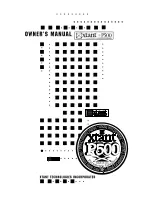
18
ULTRA-Q PRO PEQ2200
8. SPECIAL APPLICATIONS
8.1 Equalizing a sound reinforcement system
Before you insert an equalizer in your sound reinforcement system, you should clearly define its tasks. If you
fail to set up the EQ properly, it might deteriorate the sound image more than if you used no sound-processing
device at all.
In a sound reinforcement system equalizers are used in three major areas of application:
1.
Reducing the risk of feedback, while increasing the overall volume level.
2.
Improving the natural sound of music.
3.
Improving the intelligibility of speech.
It is quite obvious that compromises must be made to meet these requirements. In rooms with poor acoustics
or a high level of background noise, both natural sound and acoustic power can usually not be realized
simultaneously. Priority must be given to one of these quality-improving measures.
However, it should be noted that even a perfectly natural sound is useless if the audience has difficulties
understanding what a speaker says, for example at an election campaign rally!
Before you start equalizing your system it will be useful to play back some music or speech program without
equalization. If the sound is distorted you should first try to eliminate this problem. In order to get a feel for the
room acoustics it might be helpful to sweep a sine tone generator over the entire audio range (i.e. the
frequency range from 20 Hz to 20 kHz), which is better than playing back a signal consisting of pink noise, as
it will enable you to identify weak points (room resonances, distortion, rattling noise) of both system and
location. In particular, the critical range between 2 and 4 kHz should be tested (if required, use the BEHRINGER
ULTRA-Q PRO as a band-pass filter to limit the frequency range). If you detect any problems, these are
definitely caused by the system itself and should not be fixed with an equalizer!
Finally, use the ULTRA-Q PRO to fine-tune the system.
+
If extreme equalizer settings are necessary to achieve a usable frequency response, the alarm
bell should start ringing!
This does not mean that such settings should generally not be used, often enough they cannot be avoided if
the room acoustics are poor. Nevertheless, you should always try to change the room acoustics before you
start tweaking the response curve drastically.
Once the basic setting has been found, you can fine-tune the system using music and speech signals. If you
own a so-called real-time analyzer (RTA) make sure that the measuring microphone is properly positioned. It
should be placed directly within the dispersion field of the sound system without being disturbed by acoustic
characteristics of the room. Avoid placing it behind curtains, less than 1 m away from the walls, or on an open
balcony, as this would impair your measurements.
We recommend that you move the measuring mic on a circular line in front of the stage, so that you can
compare the measured results. In this context it should be made sure that the frequency response diagrams
do not differ excessively from each other. If you encounter any problems, change the position of the measuring
mic or check the system for proper phase.
Please verify that any background noise is at least 6 dB (better 10 dB) lower in level than your operating level;
otherwise you cannot trust your measurements!
Once the system has been adjusted as accurately as possible to yield the desired response curve, walk
around in the audience area and listen to the sound produced at various places. Remember to give your hearing
some pauses during the test and use different music or speech programs, so that you get a feel for the
response characteristics of the sound system.
It takes a lot of time and patience to set up an equalizer properly!
Additionally, you could experiment with a stage or house microphones directly connected to the analyzer, as
this will give you some clues as to local reflections, acoustic resonances and the lateral dispersion character-
istics of the speakers. Once the overall adjustment of the sound system has been completed, any further
corrections should not be made on the system itself but in the respective channels of the mixing console, in
particular, when you find that certain microphones are susceptible to feedback.
8. SPECIAL APPLICATIONS




































